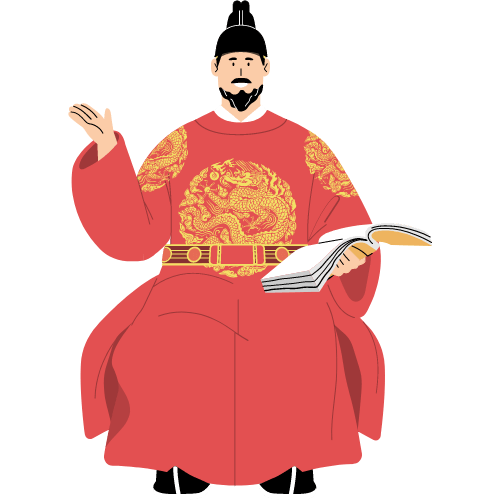Learning Guide of
Hangeul

Hangeul also spelled Hangul is the alphabetic system used to write the Korean language. This writing system consists of 24 letters, including 14 consonants and 10 vowels. Consonant characters are formed with curved or angular lines. Vowels are composed of straight vertical or horizontal lines as well as short lines on either side of the main line.
한글
Contents
Introduction
Hangeul 한글, the official alphabet of South Korea, is far more than a writing system. When King Sejong the Great created it in 1443, he sparked a cultural and social revolution. A visionary at heart, King Sejong wanted every person—no matter their status—to be able to read and write the Korean language. His dream was to give everyone a voice and access to knowledge, especially those who had previously been left behind.
Before hangeul came along, Koreans used Chinese characters called hanja to write their language. Although these symbols could express complex ideas, they took years of dedicated study to master—something only the elite could afford. Meanwhile, most people, like farmers and common folk, had neither the time nor the resources to learn. These barriers kept them from reading, writing, and fully participating in public life.
Faced with this unfairness, King Sejong took action. He brought together a group of scholars from the Jiphyeonjeon (“Hall of Worthies”) and tasked them with devising an entirely new alphabet—one that would be logical, easy to grasp, and specifically tailored to Korean. After years of painstaking work, their creation, hangeul, was born.
What makes hangeul so special is its clear, scientific design. It has 14 consonants and 10 vowels, and each letter’s shape is based on the position of the mouth, tongue, or throat when pronouncing the sound. Take the consonant “ㄱ,” for example—it was crafted to mirror the tongue touching the back of the palate to form the “g” sound. This clever approach not only makes the alphabet straightforward to learn but also supports an intuitive grasp of pronunciation.
Yet hangeul isn’t just a practical tool; it’s deeply rooted in humanistic values. King Sejong’s core aim was to bring down the walls separating the literate from the illiterate so that every person, from commoners to royalty, could share their thoughts in writing. Because of this visionary project, literacy rates in Korea soared, and hangeul became central to the nation’s cultural pride and intellectual advancement.
Every year on October 9th, South Korea celebrates “Hangeul Day” (한글날) to honor this remarkable gift that transformed Korean history. Hangeul isn’t just an alphabet; it’s a powerful symbol of innovation, equality, and the compassion of a leader who believed in empowering his people. And King Sejong’s spirit lives on—captured in every stroke of these letters and in the resilient, creative culture they continue to shape.

How it works?
Hangeul consists of 14 consonants and 10 vowels, which means there are 24 or letters in total. Since all words in Korean are made up of syllables, let's take a look at the basic rules:
- A syllable always begins with a consonant
- A syllable has at least one consonant and one vowel
- Each syllable is in the form of a square
Each block in hangeul always has at least one consonant and one vowel, and sometimes it includes a final consonant, which is called batchim in Korean. Let’s take a simple example: the word 한글 (hangeul). This word is made up of two syllables: 한 (han) and 글 (geul). In the first syllable, 한, you start with the consonant ㅎ (h), followed by the vowel ㅏ (a), and then the final consonant ㄴ (n).
And there you have it—a complete syllable! The second syllable, 글, works the same way: the consonant ㄱ (g) comes first, then the vowel ㅡ (eu), and finally the consonant ㄹ (l) rounds it out. Everything fits neatly into these little square blocks, which makes hangeul not only super easy to read but also really satisfying to write.

In Korean, every syllable is made up of at least one consonant and one vowel—this is a pretty fundamental rule of writing in hangeul. It’s not just logical; it also mirrors the phonetic nature of the Korean language. What this really means is that you won’t find any standalone syllables kicking off with just a vowel.
When a word or syllable needs to start with a vowel sound, they use a silent consonant called ㅇ (ieung) as a sort of placeholder at the beginning. Now, this consonant doesn’t make any sound when it’s at the front, but it’s super important for keeping the syllabic structure intact in hangeul.

Every syllable in hangeul is organized into a neat little square or block, which makes it super easy to visually identify each sound unit. Unlike the linear writing systems you see in Western languages like English or French, where letters just line up one after the other, hangeul combines consonants and vowels to create a unique syllabic block that you can read at a glance.
Take the word 서울 (Seoul), the capital of South Korea, for example. It’s made up of two syllables: 서 and 울. In the first block, 서, you’ve got the consonant ㅅ (s) sitting at the top, with the vowel ㅓ (eo) right below it, forming a balanced syllable. Then, in the second block, 울, the consonant ㅇ (ieung) acts as a silent placeholder at the top, while the vowel ㅜ (u) is just underneath, and the final consonant ㄹ (l) sits at the bottom of the block.

The Hangul alphabet
Find below the tables categorized by letter types, offering a clear breakdown of simple consonants, double consonants, simple vowels, and compound or double vowels.
Basic Consonants
기본 자음
There are 14 simple consonants which are grouped into two categories: aspirated consonants and unaspirated consonants. Aspirated consonants are produced with a small burst of air, while unaspirated consonants are produced without this air burst.
Double Consonants
쌍자음
In Korean, there are also compound consonants, double consonants or also called 'combined consonants'. They are formed by combining two single consonants to form a new consonant which has a stronger pronunciation.
Vowels
모음
Korean vowels are the basic sounds used in the Korean language to form syllables. There are ten simple vowels and eleven compound vowels in Korean. Simple vowels are pure sounds that are pronounced without changing the shape of the mouth or the position of the tongue. Compound vowels, on the other hand, are formed by combining two simple vowels to form a new sound.
Vowels Combinations
복합 모음
By combining two basic vowels in the Hangeul writing system, it is possible to create an expanded set of eleven compound vowels. The compound vowels, also known as double vowels, are formed by merging two simple vowels.
Need a Course?
Learn Hangeul
Progressive Lesson
Learn to read and write each letter through a progressive journey to effectively assimilate each character.
Practical Exercise
Practice each letter learned with flashcards, memory games as well as word reading exercises (+80 words).
Even More
And also, stroke order, pronunciation, writing sheets (for members). As well as summary tables, wallpapers and many more.

Learn to read and write hangeul now
💡 With a premium subscription receive a writing book and worksheets with each lesson, as well as access to the course to learn how to express yourself in Korean.
Hangeul Chart
한글표
Here is a table with the basic consonants and vowels and their possible combinations. You can view the romanized version by clicking the button below.
Idea of use
Read each syllable aloud and check with the romanization option if your pronunciation is correct.
| ㅏ | ㅑ | ㅓ | ㅕ | ㅗ | ㅛ | ㅜ | ㅠ | ㅡ | ㅣ | |
|---|---|---|---|---|---|---|---|---|---|---|
| ㄱ |
가 ga |
갸 gya |
거 geo |
겨 gyeo |
고 go |
교 gyo |
구 gu |
규 gyu |
그 geu |
기 gi |
| ㄴ |
나 na |
냐 nya |
너 neo |
녀 nyeo |
노 no |
뇨 nyo |
누 nu |
뉴 nyu |
느 neu |
니 ni |
| ㄷ |
다 da |
댜 dya |
더 deo |
뎌 dyeo |
도 do |
됴 dyo |
두 du |
듀 dyu |
드 deu |
디 di |
| ㄹ |
라 ra |
랴 rya |
러 reo |
려 ryeo |
로 ro |
료 ryo |
루 ru |
류 ryu |
르 reu |
리 ri |
| ㅁ |
마 ma |
먀 mya |
머 meo |
며 myeo |
모 mo |
묘 myo |
무 mu |
뮤 myu |
므 meu |
미 mi |
| ㅂ |
바 ba |
뱌 bya |
버 beo |
벼 byeo |
보 bo |
뵤 byo |
부 bu |
뷰 byu |
브 beu |
비 bi |
| ㅅ |
사 sa |
샤 sya |
서 seo |
셔 syeo |
소 so |
쇼 syo |
수 su |
슈 syu |
스 seu |
시 si |
| ㅇ |
아 a |
야 ya |
어 eo |
여 yeo |
오 o |
요 yo |
우 u |
유 yu |
으 eu |
이 i |
| ㅈ |
자 ja |
쟈 jya |
저 jeo |
져 jyeo |
조 jo |
죠 jyo |
주 ju |
쥬 jyu |
즈 jeu |
지 ji |
| ㅊ |
차 cha |
챠 chya |
처 cheo |
쳐 chyeo |
초 cho |
쵸 chyo |
추 chu |
츄 chyu |
츠 cheu |
치 chi |
| ㅋ |
카 ka |
캬 kya |
커 keo |
켜 kyeo |
코 ko |
쿄 kyo |
쿠 ku |
큐 kyu |
크 keu |
키 ki |
| ㅌ |
타 ta |
탸 tya |
터 teo |
텨 tyeo |
토 to |
툐 tyo |
투 tu |
튜 tyu |
트 teu |
티 ti |
| ㅍ |
파 pa |
퍄 pya |
퍼 peo |
펴 pyeo |
포 po |
표 pyo |
푸 pu |
퓨 pyu |
프 peu |
피 pi |
| ㅎ |
하 ha |
햐 hya |
허 heo |
혀 hyeo |
호 ho |
효 hyo |
후 hu |
휴 hyu |
흐 heu |
히 hi |



 Japanese
Japanese
 Korean
Korean
